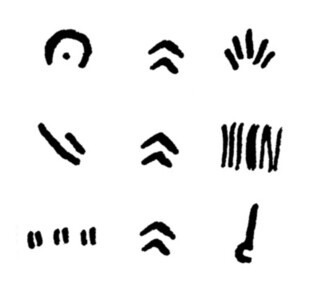In August 2006 I visited an architect friend called David Martin who lived near the town of Montignac in the Dordogne. He was in the middle of a complicated job converting the interior of a nearby château, which had been acquired by a wealthy Japanese client. One evening he produced a large and rather dirty wooden crate. ‘I found it tucked away at the back of a cupboard in the château. They’re the papers of a local poet who used to live there, Jean-Luc Champerret. Have you heard of him?’
The crate, when I finally opened it, contained papers, some loose, some tied in bundles, all covered with thick brown dust, along with a few rusty pens, some pieces of charcoal, several bundles of letters, three small notebooks – one black, one grey, one blue – and six copies of a volume of poems by Champerret, Chants de la Dordogne, published in 1941 by a small press in Perigueux, Editions du Noir (presumably a reference to Perigord Noir, the region south of Perigueux, which takes its name from the black oaks that grow there). The poems were written in rhyming alexandrines, and were based on, or attempted to re-create, peasant songs from the region. The papers were fragile, and some of the leaves turned to dust when you picked them up. What survived included notes, and more poems, written in much shorter lines, accompanied by diagrams reminiscent of Chinese calligraphy, and a number of abstract drawings in charcoal done on standard Bureau de Poste blank postcards. There were also a number of visual poems with words and letters of various sizes distributed sparsely across the page, perhaps indebted to Apollinaire, certainly influenced by Mallarmé’s Un coup de dés, of which they seemed a belated imitation. The grey notebook, the first I opened, had the title ‘Notes sur Lascaux’, and was written in pencil. The first 36 pages were filled with writing and diagrams in a diminutive and impenetrable script. The rest of the notebook was blank.
There was little on record about Champerret – I could find no other trace of Chants de la Dordogne, and the Bibliothèque Nationale did not hold a copy. He didn’t appear to have published any other works. My few contacts in university French departments hadn’t heard of him. However I did manage to track down his birth certificate via the mairie in Montignac. He was born in the village of Le Moustier, on the road from Les Eyzies to Montignac, on 11 September 1910, to Alice Rose Champerret and Gaston Yves Champerret. But there was nothing more. David Martin put me in touch with Isabelle Dupois, who had worked as a housemaid at the château where the crate had been found. She told me that Champerret had been living in Paris when the war began, and had, she thought, briefly been a member of a Resistance cell that included a tall wiry Irishman, before being forced to flee from the capital, returning to the Dordogne. There, he had gone to live in the château, which had been requisitioned by the local Resistance. He was a quiet man, who didn’t give much away, but she knew that he had worked as a codebreaker. When Lascaux was discovered by four schoolboys and their dog Robot on 12 September 1940 Champerret was sent by his cell to survey the caves, in case they could be used as a hideout for Resistance members. Nothing came of this: within days everyone in the area knew about the discovery of a new and remarkable set of cave paintings in the hills to the south of Montignac. Then in February 1942 the château was raided by the Gestapo. Champerret got away, but Dupois knew nothing of his subsequent movements. ‘Did he ever marry?’ I asked her. ‘Non,’ she replied emphatically, ‘ce n’était pas le type.’
The notebooks, I soon realised, supplied the key to Champerret’s work. During his clandestine excursion to Lascaux, made before any archaeologists had set foot there, Champerret had not only evaluated the caves’ potential for Resistance operations, but had looked very closely at the paintings, and particularly at the signs and marks. He used his skills as a codebreaker to examine them, and the notebooks contain the fruit of his ruminations. They are not always easy to decipher, and some of the pages are missing, many are blank, and at apparently crucial points they seem to have been chewed by rodents. And they are notebooks: the arguments are not made or advanced systematically.
Champerret seems to suggest that the signs he found in the caves – signs subsequent generations have almost unanimously deemed uninterpretable – should be read as a primitive form of writing, and in the last pages of the Carnet Bleu proposes meanings that should be attached to each sign. A row of vertical lines might perhaps represent spears, or a forest, or even rain. An upturned ‘v’ sign (or two such signs, one on top of the other) might represent mountains, or huts. A line of dots might represent people, or a journey, or faces, or stars. A row of horizontal lines might represent mist or night. A sign resembling an upturned question mark might represent a club; a sign resembling three-quarters of a circle with a dot in the middle, an eye; a meandering line or group of lines a river, and so on. ‘Le signe,’ he remarks at one point, ‘n’est jamais arbitraire.’ These signs, he argues, could be linked together to form primitive sentences, or to carry messages if scratched on a stone or a piece of bark, or in the earth with a stick. Or they might just record a transaction between tribes. So, for example, the sign for mountains in conjunction with the sign for journey could imply that a hunting party had crossed the mountains. A group of signs representing antlers might record the goods handed over in an exchange.
Champerret draws attention to the three by three square grids frequently found on the walls of the cave, most notably in the polychrome blazon below the Black Cow in the nave of Lascaux. Taking a leap in the dark – and is this not what the bounding horses lining the ceiling of Lascaux’s axial gallery ask us to do? – Champerret proposes that these grids act as frameworks for the insertion of signs. Just as the signs for mountain and journey, placed in conjunction, acquire meanings, so a grid filled with signs and scratched on a stone might carry a message. When the grid is filled with signs representing the forest and signs for fire, for example, it might be a warning that the forest will burn. But Champerret goes further, proposing that although the grids may originally have been used for practical purposes, they evolved to form the basis of the first written poetry. This is an astonishing proposition.
Just as Wittgenstein argues that one does not learn a game by reading a book of rules but by playing it, Champerret seems to have believed that practice would prove or disprove the validity of his idea, and so he began to write poetry using these signs and grids. It’s unclear whether he decided on possible meanings for individual signs in advance, or whether the process of composition suggested these meanings, but the latter seems more likely. The notes attached to each sign seem to have been added to and developed as he worked on the poems.
Beginning from the premise that nine signs taken from the cave network and inserted into the three by three grid would make a poem, Champerret wrote (if we include his variants) more than six hundred of them. His method can be split into five stages: a) he fills the grid with signs; b) he ‘translates’ the signs minimally into French; c) he writes through the first translation, adding connector words, so that the poem reads more easily in modern French, translating the three by three structure of the grid into three stanzas of three lines each; d) he writes a first variation on the poem, elaborating some of the lines, and embellishing the detail, as a shaman or an oral poet might vary the bare outline of an inherited story; e) he repeats this process, continuing to elaborate and embellish the original, all the while maintaining the stanzaic pattern, although the lines are progressively indented to echo the original three by three structure as it is distributed laterally as well as vertically across the page.
Here is one of these poems, in its variant translated forms:
a)
b)
eye bison sun
horns bison spears
legs bison clubc)
The eye
of the bison
is the sunthe horns
of the bison
are spearsthe legs
of the bison
are clubsd)
The eye
of the bison
is like the bright sunthe horns
of the bison
are like sharp spearsthe legs
of the bison
are like heavy clubse)
The white eye
of the black bison
is like a star at nightthe curved horns
of the black bison
are like sharp spearsthe thick legs
of the black bison
are like heavy clubs
Champerret continued his explorations in his Carnet Bleu, experimenting with other grids he found at Lascaux: single squares, for a single sign; squares divided by a vertical line, where two signs could be inserted; squares divided by two vertical lines and one horizontal line, where six signs could be inserted; and four by four grids, accommodating sixteen signs. With these grids, Champerret was able to write short poems, originating from a single sign, as well as longer narratives.
One of the letters in the crate suggests that he wrote a document, now lost, explaining his work. The letter is from the director of the Musée de l’Homme, Paul Rivet, and is dated June 1941.
Dear Sir,
Thank you for your essay on the caves at Lascaux and the mysterious signs therein. We have received a great deal of correspondence regarding Lascaux since its discovery in September 1940, and unfortunately it is not possible to respond to every inquiry in detail. The study of Upper Paleolithic parietal art is a science, and should be left in the hands of specialists, as interference by amateurs can only cause damage to this sacred national inheritance in the long term. Your work is pure fantasy. The signs you describe bear no resemblance to those that have been discovered at Lascaux, and meticulously recorded in tracings and documented in detail by the Abbé Breuil, as outlined in his report presented to the Académie des Inscriptions et des Belles Lettres in October 1940.
I sincerely discourage you from pursuing your speculations, and advise you at this moment of national turpitude to direct your not inconsiderable energies elsewhere.
Rivet’s belief that there were discrepancies between Champerret’s collection of signs and those at Lascaux is not without foundation, yet his dismissal is precipitate. He had other things on his mind: in June 1941 he was busy establishing a Resistance network operating out of the Musée de l’Homme. Indeed, in his letter, he clearly urges Champerret to get involved with the Resistance himself, unaware of the mission that had brought the poet to the caves in the first place.
Send Letters To:
The Editor
London Review of Books,
28 Little Russell Street
London, WC1A 2HN
letters@lrb.co.uk
Please include name, address, and a telephone number.


